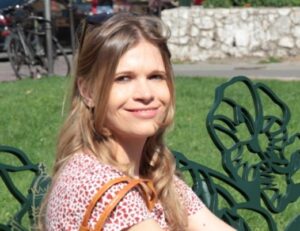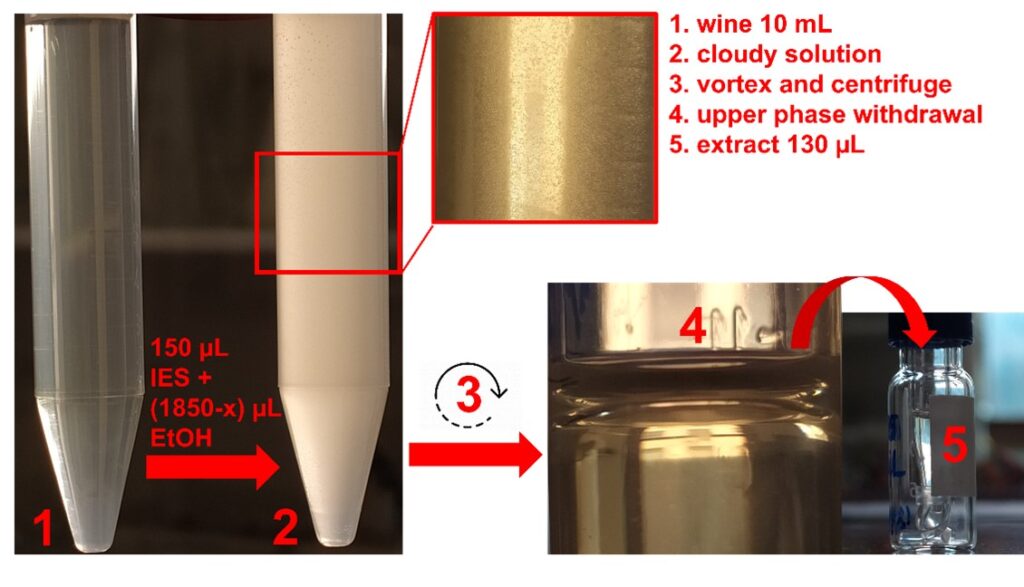By Alessandra Gentili and Chiara Dal Bosco
High performance liquid chromatography combined with mass spectrometric detection (HPLC-MS) is a powerful and highly sensitive analytical technique which is widely used for the determination of pesticide residues in wine1, 2. In order to exploit the full potential of the technique and to maximize the achievable sensitivity, a sample pretreatment is often necessary when dealing with real matrices. This sample preparation step is important for improving the signal-to-noise ratio of the chromatographic peaks and, therefore, to meet the limits fixed by the EU regulation for the maximum allowed concentration of pesticides in grapes and wines (maximum residue levels, MRLs)3. Many sample preparation techniques are nowadays available, both in solid and in liquid phase. The ongoing research is encouraging the use of miniaturized techniques, with the aim of reducing the waste production and replacing the toxic petroleum-based solvents with more safe and environmentally friendly ones. In this research, the powerful and popular technique of dispersive liquid-liquid microextraction (DLLME) has been applied for the determination of pesticides in wine samples of different cultivar and geographic areas. The DLLME technique (Figure 1) is based on the use of a solvent mixture composed of an extractant, which is an organic phase immiscible with the aqueous sample, and a dispersant, which is miscible with both the extractant and the sample: the rapid injection of the mixture into the sample promotes a fine dispersion of the extractant within the aqueous phase (cloudy solution); the resulting increase of the contact area between the extractant and the sample solution speeds up the mass transfer of the analytes into the organic phase. Traditionally, the last one was a toxic and not environmentally friendly chlorinated solvent4. In this study, we propose as green extractant an ideal eutectic solvent (IES) based on L-menthol and butylated hydroxytoluene, blended in a molar ratio of 3 to 1 (MEN:BHT (3:1)). L-menthol has been chosen for its natural derivation, absence of toxicity, and tendency to form hydrophobic eutectic mixtures with selected compounds; BHT is a safe and cheap hindered phenolic compound used as antioxidant by food, cosmetic, and pharmaceutical industry. This IES with marked antioxidant properties has previously been employed by our group for the extraction of fat-soluble vitamins and carotenoids from fruit juices, in combination with ethanol as dispersant5. Here, its application to wine samples appears particularly convenient, since the endogenous ethanol of wine has been used, thus allowing one to reduce solvent consumption.
Figure 1. Scheme of the DLLME procedure on wine sample with a certain alcoholic content (x μL of ethanol).
The developed DLLME-HPLC-MS method has been validated in matrix for 19 pesticides belonging to different chemical classes: it is characterized by average recovery as high as 80%, precision between 3% and 14%, and limits of detection (LODs) and quantification (LOQs) much lower than the maximum residue levels fixed by the EU regulation for grapes and wines. Therefore, it is suitable for monitoring the pesticide levels in commercial wines from both conventional and biological agriculture, with the further advantages of being quick, cheap and in compliance with the green analytical chemistry. From the analysis of 11 commercial wines it was found that just in a bio sample the target compounds were not detectable or lower than quantification limit; as for the other samples, the most widespread and abundant pesticides were methoxyfenozide and boscalid, but their levels were much lower than the relative MRLs.
Within this application, to the best of our knowledge, this is the only method that employs a green extractant solvent combined with a green dispersant solvent, such as ethanol, while at the same time minimizing its consumption by taking advantage of the alcoholic endogenous content of wine.
Read more at: https://www.mdpi.com/1420-3049/27/3/908

Alessandra Gentili is a Full professor of Analytical Chemistry at the University of Rome La Sapienza, where she received her Master’s degree, Magna cum Laude, in Industrial Chemistry and her PhD degree in Chemical Sciences. She was a researcher from 1999 to 2004. He earned his national eligibility as a Full Professor, CHIM 01 (session 2012). Currently, she teaches “Analytical Chemistry III with laboratory” for the Bachelor’s Degree in Chemistry (AL channel) and is a member of the Doctorate Committee of the PhD Program in “Chemical Processes for Industry and Environment” as well as of the Monitoring Committee -Teaching of the Science Faculty. She is a supervisor of bachelor’s, master’s and doctoral theses. The results of her research have been published over 75 papers on international journals and 9 chapters on international books (h-index; 2550 citations ). She has been a referee for ISI journals belonging to top-decile/quartile in her research area. She is a member of the Editorial Board of Journal of Chromatography A, Molecules and CAC.She was an evaluator of the research activity of the Institutes of the Czech Academy of Sciences and an international referee of both International research projects (Kuwait Foundation for the Advancement of Science; Ghent University; Chilean Government FONDECYT Program) and PhD Theses (Universidad de La Laguna, Spain). She has collaborated with national (IMC-CNR Montelibretti; UNICATT Cord and Neonatology Unit of Policlinico Gemelli, Università Cattolica del Sacro Cuore di Roma) and international (Universidad de Alcalá, Madrid, Spain; Consejo Superior de Investigaciones Cientifica, Barcelona, Spain; “Arca La Sapienza” project, Italy-Ecuador) Universities and Research Centres.In 2006, she was invited by the IIQAB-CSIC (Proff. Barcelo and Petrovic) to join the European network of reference laboratories GC-MS and LC-MS, as part of the project NORMAN.
Research activity:
Prof. Gentili’s research essentially concerns the study of original analytical methodologies aimed at solving problems in different areas of Chemistry, namely Clinical, Food and Environmental Chemistry. The themes of her research include the development of innovative extraction procedures (static and dynamic pressurized liquid extraction, (micro)solid phase extraction based on last generation sorbent materials, DLLME relying on green solvents) and the use of multihyphenated analytical techniques ((nano) liquid chromatography/diode array detection/mass spectrometry). Particular interest has been focused on strategies able to “profile” organic micronutrients (vitamins and carotenoids) in food and biological matrices. From 2013 to 2015, her research group participated in the KEQAS (vitamin K External Quality Assurance Scheme), an international system managed by the Nutristasis Unit (Guy’s and St. Thomas’ Hospital, London, United Kingdom) that monitors and reports on accuracy of the vitamin K analysis.

Chiara Dal Bosco obtained the Ph.D. in Chemical Sciences from Sapienza University of Rome. She is engaged in research on Green Analytical Chemistry at the Chemistry Department of Sapienza University of Rome, in the research group of prof. Alessandra Gentili. In the period 2016-2018 she worked at the Chemistry Department of Sapienza University of Rome, where she performed research on the development and validation of analytical methods for quantitation of vitamins and carotenoids in foodstuffs and biological samples, and also on the synthesis of cellulose-based materials as substrate for advanced devices. In 2015 she earned post-Master degree specialization in “Analytical chemistry and quality control” at the Chemistry Department of Sapienza University of Rome, where she previously graduated summa cum laude with a thesis concerning the synthesis and characterization of cellulose-based hydrogels to be used as gel electrolytes in the research group of prof. Stefania Panero.
Research activity:
Development of eco-friendly materials for Green Sample Preparation. Development and validation of analytical methods. Organic micronutrient profiling of foods and biological fluids.
References
- Timofeeva, I.; Kanashina, D.; Moskvin, L.; Bulatov, A. An evaporation-assisted dispersive liquid–liquid microextraction technique as a simple tool for high performance liquid chromatography tandem–mass spectrometry determination of insecticides in wine. J. Chromatogr. A 2017, 1512, 107–114, https://doi.org/10.1016/j.chroma.2017.07.034
- Narenderan, S.T.; Meyyanathan, S.N.; Babu, B. Review of pesticide residue analysis in fruits and vegetables. Pre-treatment, extraction and detection techniques. Food Res. Int. 2020, 133, 109141, https://doi.org/10.1016/j.foodres.2020.109141
- European Union. Regulation (EC) No 396/2005 of the European Parliament and of the Council of 23 February 2005 on maximum residue levels of pesticides in or on food and feed of plant and animal origin and amending council directive 91/414/EEC 2020 (consolidated text). Off. J. Eur. Union 2005, 70, 1–16.
- Rezaee, M.; Assadi, Y.; Hosseini, M.R.M.; Aghaee, E.; Ahmadi, F.; Berijani, S. Determination of organic compounds in water using dispersive liquid–liquid microextraction. J. Chromatogr. A 2006, 1116, 1–9, https://doi.org/10.1016/j.chroma.2006.03.007
- Dal Bosco, C.; Di Lisio, V.; D’Angelo, P.; Gentili, A. Hydrophobic eutectic solvent with antioxidant properties: Application for the dispersive liquid—Liquid microextraction of fat-soluble micronutrients from fruit juices. ACS Sustain. Chem. Eng. 2021, 24, 8170–8178, https://doi.org/10.1021/acssuschemeng.1c01473


